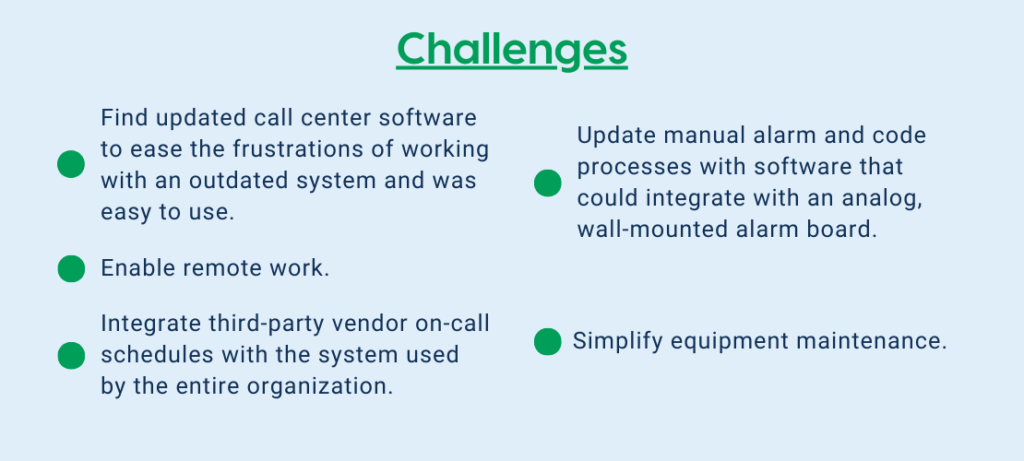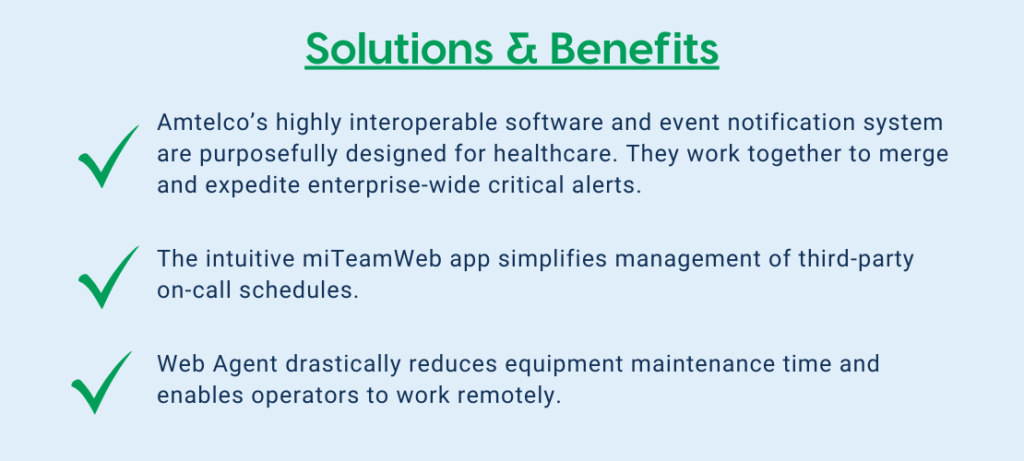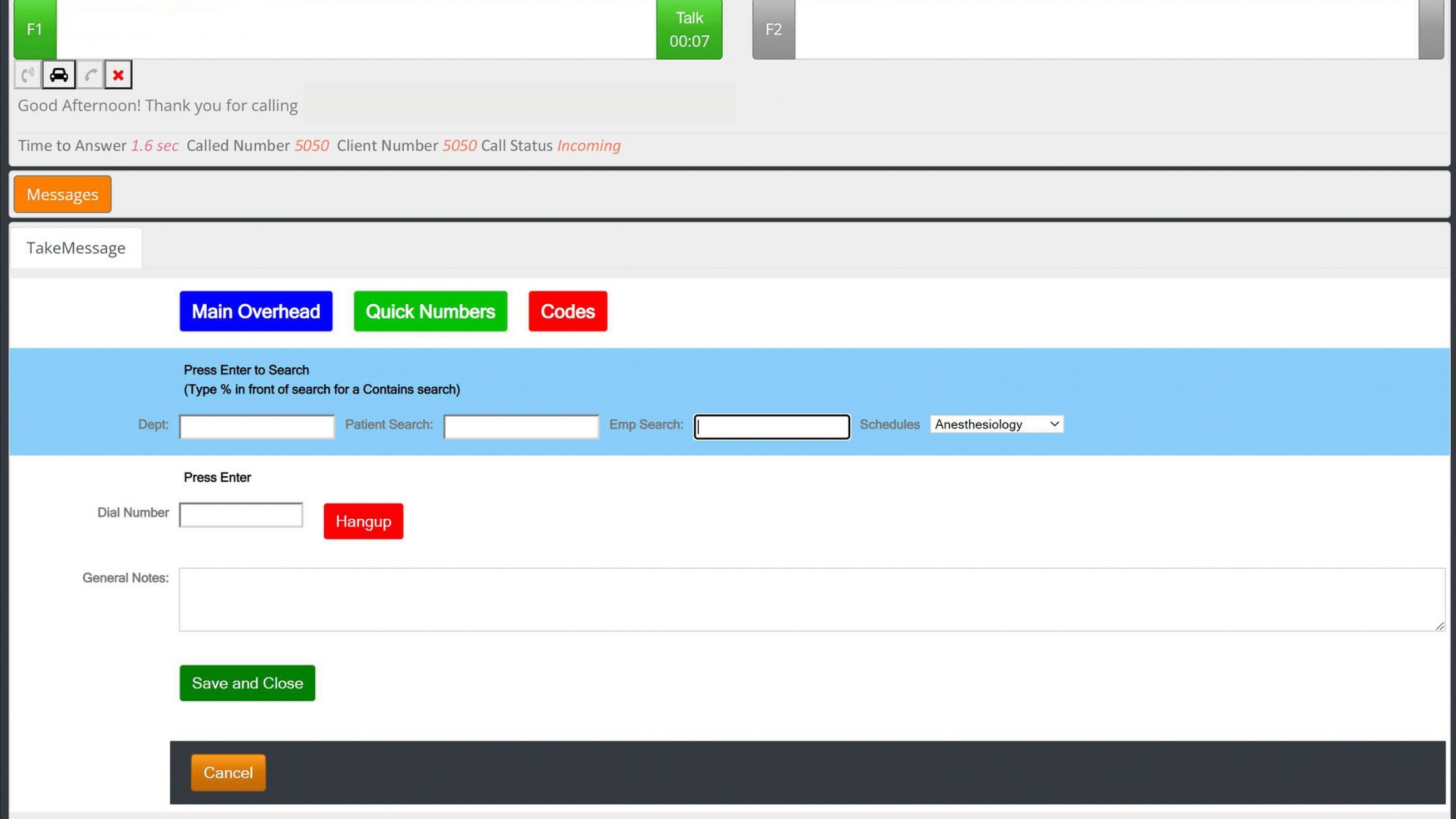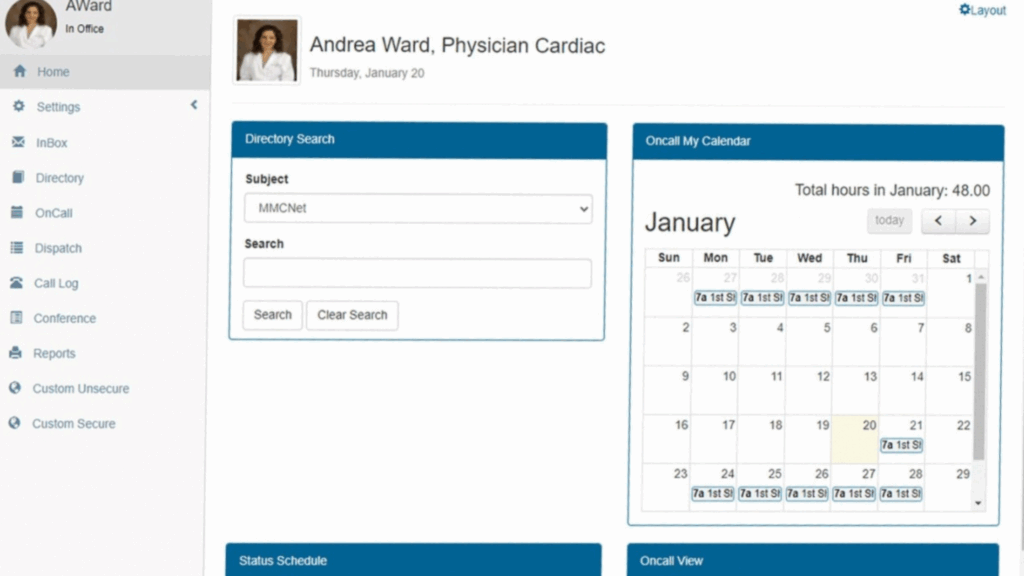NorthBay Health is a non-profit healthcare organization located in Solano County, California. The system was founded by physicians and community leaders in 1959 with the opening of Intercommunity Hospital in Fairfield. Intercommunity Hospital was renamed NorthBay Medical Center and has expanded from 32 beds to 154 beds.
Over the years, NorthBay Health has grown its services and facilities, including opening the 50-bed NorthBay VacaValley Hospital in Vacaville and two Urgent Care Centers. Today, NorthBay Health Medical Center and NorthBay VacaValley Hospital are both Magnet-certified from the American Nurses Credentialing Center, recognizing their excellence in nursing.
The entire NorthBay Health system is served by a single call center with a small and dedicated team of agents and managers. The organization decided to work with Amtelco after its previous vendor required pricey yearly upgrades that didn’t offer any benefits. “The financial costs were incurred without getting additional or up-to-date functionality,” says Terese Davis, MBA, CHAM, Director of Patient Access & Communications working in NorthBay Health’s Finance Division/Revenue Cycle Services. “Over the years, it felt like we had been paying annually for the same old system we had when we went live.”
NorthBay Health needed call center software that could ease the frustrations of working with an outdated system, offer more efficiency, and was easy to use. “Our PBX operators were constantly encountering issues and had to work in a downtime environment, which can impact patient safety. We were always working with IT and the vendor to restore the system and spent hours troubleshooting and testing – it was a huge headache for us,” explains Felicita Neideffer, QA Specialist at NorthBay Health. “So, I wanted a user-friendly system that would streamline the operator’s workflow and was easy to support. I didn’t want to keep dealing with issues.”

Chief Information Officer for NorthBay Health, Christopher Timbers, agrees, “We felt like there was declining support with our previous vendor, and that was a challenge. It seemed like we had to frequently escalate issues, and upgrades were not included in their maintenance. A lot of times, the answer to everything was to do a costly upgrade, but their technology wasn’t nearly what we have today with Amtelco.”
Manual to Automated Alarms and Code Calls
Many of the workflows done by NorthBay Health’s agents were manual, including their alarm and code call processes. They needed call center software that was more efficient and easier to use. Terese explains, “When an alarm came in on our old system, we had to remember which hospital location it was for, which keystrokes to use for the instructions to pop, and then we had to follow them to process the code. It was a cumbersome process, and if you missed a step because you’re reading as you’re trying to type, it was incredibly stressful because we’re dealing with critical patient care and patient lives.”
Felicita adds, “We were looking for a way to take these manual steps and put them in a form or template that could guide the operators through the alarm and code process so they wouldn’t have to think about it.”
“The time it takes to activate an alarm notification from our console went from 90 seconds to less than 10 seconds.”
Monica Belo, Sr. Systems Analyst, Revenue Cycle Applications
However, updating the alarm panels to work with new technology wasn’t a straightforward process due to California’s stringent requirements for changing anything related to fire alarm panels or duress buttons. Christopher explains, “California is unique due to the earthquake activity and seismic regulations. Therefore, anytime you open up a wall, it involves a state agency and permit process, which is expensive because usually an architect comes in to do renderings. Then, it all goes through an approval process which, can be lengthy. It’s designed to protect our patients and ensure we have a safe physical environment for them, but it can be a challenge when you just want to make a simple cable change or move something that’s wall-mounted.”
When thinking about interoperability and data flow, it’s easy to forget that sometimes the systems that need to exchange information are analog. They were never designed or built for a digital environment. Due to its older alarm configuration, this was exactly the situation at NorthBay Health.
People from Amtelco’s on-site support worked with the NorthBay Health team and took a deep dive into their alarm system. Thanks to their efforts and decades of experience, they found a solution that enabled their analog alarm board to share information with the new software from Amtelco without involving the state. This fix saved a substantial amount of money and time.

Amtelco’s event notification system was purposefully designed to merge and expedite enterprise-wide critical alerts in healthcare environments. The integration engine captures requests from hospital systems, including information from analog systems, and the software instantly sends those notifications via the on-call scheduling module to an individual, an entire group, or the current on-call personnel. All statistics are accumulated for each notification, providing an easy-to-follow audit trail for reporting purposes.
The operators at NorthBay Health handle more than 20 codes, as well as serial and panic alarms. Monica Belo, Sr. Systems Analyst, Revenue Cycle Applications at NorthBay Health, comments, “The time it takes to activate an alarm notification from our console went from 90 seconds to less than 10 seconds.” Terese adds, “We used to manually type information for our overhead page – ‘code blue, room X,’ – before we could get the code out. Now it’s seamless. We don’t have to do any of that because the system is pushing all the info for us. The application processes those emergency alarms so quickly and efficiently that our operators don’t even have to think about it. Anybody could sit down and process a code using Amtelco’s software.”
Christopher adds, “Obviously, these examples are some of the most critical things we do when time is of the essence. So, to see that kind of improvement is exactly what we want to achieve when we make upgrades. Plus, the alarm integration means there’s one less thing our clinicians have to think about when they’re taking care of patients. We now have a system that works for medical staff, too. It’s easy to use, intuitive, and allows them to spend more time focusing on the patient and the care they’re giving.”
“One of our operator leads is involved with the fire drill process for the organization,” continues Monica. “A real fire alarm came through shortly after installing Amtelco’s software and went right to her console. She activated it, called 911, and then messaged Terese to ask if she had missed something because the new workflow was too easy. All the prompts are there and integrated. You don’t have to remember what to do during an emergency.”

The process is seamless to the operator who handles the alarm. In the fire alarm example, Felicita had already programmed fire alarms to go to “code red” automatically and established a specific script for the agent to follow. Felicita says, “In addition, we built redundant paging for the engineering team and anyone responding to these alarms. So by the time PBX starts to activate the code, a page has already been sent to the appropriate individuals. Scripted messages that pull information such as location and alarm type are done for each alarm.”
“Alarm and code calls make your heart pound,” says Terese. “But with Amtelco, processing those calls is seamless now, and that stress has been removed. I think that ease of mind is the biggest benefit we’ve received.”
Managing the alarm system on their own was an enormous improvement compared to their old process. “We were dependent on our previous vendor to make changes to the alarms. In the past, adding a new alarm came with a price tag,” says Felicita. “We had to get budget approval and coordinate with the vendor – it took months. Now, we are empowered to make updates ourselves whenever we need them.”
Monica adds, “Amtelco was awesome with our implementation and getting our complicated scripts ready. Even if it was a tough ask, they would say OK, we got you, we’ll be back in a week to give you what you need. And sure enough, they were complete and ready for us to test next time we met.”
“Amtelco was here taking inventory of our IT assets, recording short training videos, and troubleshooting issues unique to our situation. Amtelco’s mindset wasn’t just, ‘we’re going to implement this.’ It was also informing us about our existing hardware and software, and teaching us how it functions.”
Felicita Neideffer, QA Specialist
Overcoming Integration Challenges
Implementing new technologies always presents challenges. Many hospitals use analog alarm systems and technologies from multiple vendors, which can present especially tricky scenarios when integrating new tech. Conducting a full IT assessment of the call center’s current technology is paramount.
Felicita states, “Our on-site support was incredibly helpful. Amtelco was here taking inventory of our IT assets, recording short training videos, and troubleshooting issues unique to our situation. Amtelco’s mindset wasn’t just, ‘we’re going to implement this.’ It was also informing us about our existing hardware and software, and teaching us how it functions. I’m an analyst, but I’m not familiar with hardware. However, that all changed by the time we were done.”
“Felicita and Amtelco’s on-site support had a great relationship. They were able to document so many helpful details,” comments Monica. “This isn’t my area of expertise, but thanks to their documentation, I was able to update and add alarms to the system on my own when Felicita was on vacation.”
Christopher explains why he feels the best products are the ones he never hears about, “Usually, if a situation has been escalated to me, then you know there’s some issue that needs executive involvement. One of the great things about our installation is that I got the status reports and read them, but I didn’t have to step in at any point or have a conversation with Amtelco. It seems like the teams worked really well together.”
Integrating On-Call Schedules
One of NorthBay Health’s goals was to integrate their third-party vendor on-call schedules into the system used by everyone else in the organization. The team engaged leadership and those who support the physicians early in the process because changing the on-call scheduling procedure was an important patient safety concern that affected departments throughout the organization.

Reliable on-call scheduling software can significantly reduce admin work, eliminate inaccurate information, and minimize scheduling errors. Call center operators and staff can instantly contact the correct on-call personnel and easily customize and maintain shift schedules. Some benefits include:
- Advance notifications about unfilled schedules.
- Other departments and staff can enter and update their own schedules.
- On-call schedules can be added to personal and mobile calendars.
- Separate schedules by location/department/specialty to reduce errors.
- Automated, real-time updates.
- Integrate on-call schedule information with a secure messaging app.
Monica says, “We are now able to use just the Amtelco miTeamWeb app to integrate and update the third-party vendor schedules. No one has to manage two or three different schedules or manually input shifts into different scheduling platforms. The app is easy for operators and hospital staff to use.”
Other departments within NorthBay Health also began using miTeamWeb for their own on-call schedules. Felicita and Monica built shells for all departments, imported their schedules, and put them in the app. Next, they trained people from other departments to use the solution.
Monica comments, “One person we trained would previously spend two or three days at the end of the month getting on-call schedules ready for the next month. Now she can get the work done in two to three hours. She then pushes the schedules to the departments so they can manage their own schedules.”
Initially, some users were resistant to the changes. “It can be difficult for some people to adjust to any new system,” says Monica. “But once they discovered how much easier miTeamWeb was to use, they loved it and became champions of it by encouraging others to use it. It was a really big win.”
Simplifying Equipment Maintenance
Server maintenance used to be a long process. “It would take months to complete server maintenance, and our old vendor didn’t always seem to understand our workflow,” says Felicita. “We have the skillset to do much of the work ourselves. Now we can get in there and just do it; implementing IT changes for PBX has been a lot faster. We still have coaching and support from Amtelco when needed, which is important to us.”
“We were doing maintenance on our system every six weeks with our previous vendor,” explains Monica. “It would result in two or three hours of downtime and require one or two analysts, a supervisor, and our technical team to join a call to ensure everything ran smoothly. It was a nightmare. Now, the server jumps from one to another in 30 seconds compared to three hours. I mean, who’s not going to want that? It’s been amazing.”

NorthBay Health uses Cisco phones. The operator team used them in the past and would have to attend Cisco maintenance calls every month or two. However, the team now has Amtelco’s Web Agent product and doesn’t use the Cisco phones. Monica says, “Our Cisco team no longer has to coordinate with us for maintenance. We just get a call that informs us when they’re going to do some maintenance. It doesn’t affect our operators, and they don’t have to go into downtime. We also no longer have to wake up at 3:00 a.m. due to the time differences to do this maintenance. It’s been a godsend.”
Using Web Agent also provided NorthBay Health with reporting functions that weren’t available in the past. Call analytics provide data to help uncover trends to improve workflows and contribute to a frictionless caller experience.
The Many Benefits of Upgrading Your Call Center Software Platform
Hospital call centers have unique needs, and organizations shouldn’t pay for solutions they don’t use or repurchase tools they already have. Updating to a highly customizable call software suite can address specific challenges. “We have a mission statement in our IT department – make NorthBay Health an easy place to practice medicine. So, even some of these behind-the-scenes tools help us achieve those goals,” says Christopher. Below, the team from NorthBay Health outlines how some of the features offered by Amtelco’s software have improved their call center.
“Everything is recorded, timestamped, and accounted for. I think the reporting functions have been one of the more important features of our new system. It’s been a relief to have easy access to all of that data.”
Monica Belo, Sr. Systems Analyst, Revenue Cycle Applications
Agent Accountability with Accurate Reporting
When call center leadership would receive the occasional RIR (rapid incident response) report in the past, it would take time to research how a code call was handled. “I’d have to go to Monica and ask her to pull the code activity on a particular date and figure out which code related to the report, and try to piece together what happened,” says Terese. “Now, I can run a quick report to see when the call connected, when the operator picked it up, and for how long they were on the phone. And crucially, I can pull the actual call recording to find out what really happened. We can defend the actions of our operators if they are blamed for an event. Managers can hear and see what happened and what the operator did or didn’t do. I can present all of this info to quickly respond to the RIR report.”
Monica agrees, “Everything is recorded, timestamped, and accounted for. I think the reporting functions have been one of the more important features of our new system. It’s been a relief to have easy access to all of that data.”
Hold and Park
The Hold and Park functions on their old system didn’t work well and led to confusion. “We had a hard time trying to get Hold and Park to work with our previous system,” says Monica. “Now we’re able to see where we’re parking the call. I can visually see that I’m moving a call to a particular extension. I’m not trying to figure out if I have another call there.”
Perfect Answer
Operators used to have to schedule time with an analyst, sit in the analyst’s office, and record their voice for messages. “We would be stuck with a greeting that we couldn’t change for at least two weeks,” says Monica.” We’d have to talk to a supervisor or figure out how to get a hold of the analyst to coordinate with his work schedule to update the recording. With Perfect Answer, operators can record messages on their own whenever they need to do so. Perfect Answer is one of my favorite tools because it has some really cool features.”
Ready Not Ready
When operators arrive and log into the system, they may not go into Ready mode. Monica explains, “We have a setting in our new system to send a pop-up to the operator’s screens after 60 seconds to ask if they are available to switch to Ready mode. Simple little things like this have made such a difference with holding people accountable, getting operators on the phones, and making the system work well, which is best for callers, agents, and our organization.”
Reduced Operator Training Time
Monica says, “Training a new PBX hire took at least four weeks when we were on our old system. Our staff would get burned out, and the new hire wanted to work independently, but it took time because there were so many scenarios to learn to be completely trained. Onboarding now takes maybe four days, and once you know the process, you know it – it won’t deviate. The procedures are very consistent, and now our onboarding is much simpler.”
“We did have some challenges with seasoned employees when transitioning to the new software,” says Monica. “They had used our previous system for at least 10 years, and questioned the workflows the first night we went live with Amtelco’s system because it was just so easy to use. The number of keystrokes they had was so much less. They would ask, ‘Is that all I need to do? Is there more? Was I supposed to click somewhere else?’ Their hesitancy disappeared after one full shift.”
Remote Work
The area where NorthBay Health is located in California is prone to wildfires. Before the transition to Amtelco, the team didn’t have a way to work remotely if a natural disaster threatened their building. Now, the team can relocate in the event of a disaster and work remotely from home or from any NorthBay Health location.
At times, Monica and Terese log into the system remotely to take calls. All of the functionality of an operator’s workstation is available to them from any desktop or laptop, wherever they may be. “I live in Georgia,” says Terese. “I’m far away, but can answer and process calls whenever needed. This is an example of the functionality enhancements we wanted to have with a new system. We are on the cutting edge now.”
NorthBay Health’s Process of Funding an Upgrade and Choosing a Vendor
It can be difficult to approach leadership with a funding request. Especially when money is tight, changes affect both staff and patients, and other departments need to be involved to complete a large project.
“I have 10 times the number of requests for new systems than we have capacity for – from both a human resource perspective and capital and operating budgets,” says Christopher. “For us, our governance process is key. I really look to some of the other senior leaders who sit with me on our IT Governance Committee to help prioritize requests.”
The IT Governance Committee has an effort value analysis they perform for all of the proposals they receive. In short, they score the difficulty of completing the request by:
- Cost.
- Maturity of the vendor(s) involved.
- Does the result align with NorthBay Health’s values and strategic plan?
The team creates a scatter diagram to get a clearer picture of what projects are low effort but have a high value. “Most projects aren’t going to be in that category. However, when we looked at Amtelco and did the scatter diagram with this project, it popped out. It aligned with a lot of the things we need to do, like replacing some old technology. I think we were also able to consolidate a couple of different products under one product with Amtelco, which helped as well.”
Once NorthBay Health identifies a vendor they want to work with, they focus on security to understand its security structure and how they approach it both technically and philosophically. “We have a great technical team. They perform the due diligence to ensure whatever is needed in the contract,” explains Christopher. “My technical team didn’t come back to me with anything negative to say about Amtelco.”
“And I just like to add that having Christopher as our CIO is great because he’s very knowledgeable and understands the technology,” comments Terese. “He is interested in what you’re asking for and wants to help. He’s not too far of a reach from us to be able to have open communication.”
Christopher says, “NorthBay Health prides itself on its agility as a small organization, and I think we’ve drawn a lot of people here from bigger organizations, myself included, who wanted a place with this kind of atmosphere. There’s not a lot of bureaucracy here. You can have real conversations, and it helps with projects like this immensely. It helps both in the system selection and also during the implementation. People are responsive if we need to make changes or escalate something.
“We identified over 90 third-party systems that will have some impact during the Epic implementation. It’s a valuable time-saver for us since Amtelco already has a partnership with Epic and can integrate with Epic’s software.”
Christopher Timbers, Chief Information Officer
Undergoing a call center system is a monumental task, but the team at NorthBay Health reflects on the benefits of going through the process. Monica says, “I really have enjoyed this this time. I know it sounds crazy, but I have enjoyed the time we spent upgrading to our new system. When others hear me say that, they think I’m exaggerating, but I’m not.”
Felicita agrees, “Amtelco empowered us to take ownership of the system from the beginning, and that was huge to us. Giving us the ability to do our own formatting and enabling us to make simple changes on the backend results in automatic, timely updates for our operators and their workflows. I’m just really grateful for our open communication with Amtelco and the hands-on training they provided during implementation. We still have that technical support if we need it now.”
The Future is Bright at NorthBay Health
As part of NorthBay Health’s strategic plan, they are finding ways to standardize and improve IT to improve access to care. “We’re involving our call center because patients call in for appointments and referrals. Like everywhere in the country right now, the wait time to get doctor appointments is way too long, and we have a big objective to cut that down. Having solid technology is a foundational element of achieving our goals.”
The system is also physically expanding by opening clinics in outlying areas. Over time, NorthBay Health will leverage the full suite of Amtelco’s applications to help in its endeavors to care for everyone within a 30-minute radius of its locations.
Another major initiative NorthBay Health is working on is migrating its electronic health record (EHR) system to Epic. NorthBay Health recognizes how readily Amtelco’s software integrates with Epic’s system. Christopher comments, “It’s fantastic when we have incumbent partners in place and ready to work with a vendor like Epic. We identified over 90 third-party systems that will have some impact during the Epic implementation. It’s a valuable time-saver for us since Amtelco already has a partnership with Epic and can integrate with Epic’s software.”



